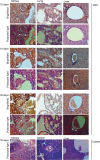The inflammasome adaptor protein ASC promotes amyloid deposition in cryopyrin-associated periodic syndromes
- PMID: 39639164
- PMCID: PMC11731034
- DOI: 10.1038/s44321-024-00176-1
The inflammasome adaptor protein ASC promotes amyloid deposition in cryopyrin-associated periodic syndromes
Abstract
In this Correspondence, P. Pelegrin and colleagues found that the deposition of amyloid in tissues in Cryopyrin-Associated Periodic Syndrome were promoted by the extracellular presence of the inflammasome adaptor protein ASC, opening exciting new directions in clinical practice to obtain a novel therapy towards secondary amyloidosis in inflammasomopathies.
Conflict of interest statement
Disclosure and competing interests statement. PP and JJMG declare that they are inventors in a patent filed on March 2020 by the Fundación para la Formación e Investigación Sanitaria de la Región de Murcia (PCT/EP2020/056729) for a method to identify NLRP3-immunocompromised sepsis patients. PP, LH-N, JJMG and ABM are co-founders of Viva in vitro diagnostics SL, but declare that the research was conducted in the absence of any commercial or financial relationships that could be construed as a potential conflict of interest. The remaining authors declare no competing interests.
Figures




References
-
- Balci-Peynircioglu B, Waite AL, Schaner P, Taskiran ZE, Taskiran ZE, Richards N, Orhan D, Orhan D, Gucer S, Gucer S et al (2008) Expression of ASC in renal tissues of familial Mediterranean fever patients with amyloidosis: postulating a role for ASC in AA type amyloid deposition. Exp Biol Med 233:1324–1333 - PubMed
-
- Baroja-Mazo A, Martín-Sánchez F, Gomez AI, Martínez CM, Amores-Iniesta J, Compan V, Barberà-Cremades M, Yagüe J, Ruiz-Ortiz E, Antón J et al (2014) The NLRP3 inflammasome is released as a particulate danger signal that amplifies the inflammatory response. Nat Immunol 15:738–748 - PubMed
-
- Bertoni A, Carta S, Baldovini C, Penco F, Balza E, Borghini S, Di Duca M, Ognio E, Signori A, Nozza P et al (2020) A novel knock-in mouse model of cryopyrin-associated periodic syndromes with development of amyloidosis: therapeutic efficacy of proton pump inhibitors. J Allergy Clin Immunol 145:368–378.e13 - PubMed
Publication types
Grants and funding
LinkOut - more resources
Full Text Sources
Molecular Biology Databases
Miscellaneous

